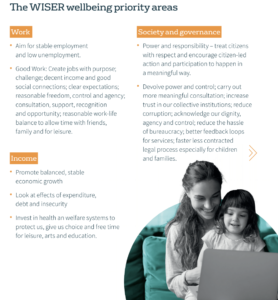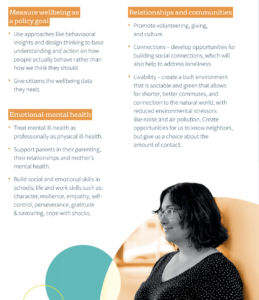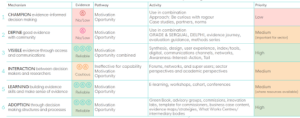How to maximise your local wellbeing impact
Knowing ‘What Works’ to maximise wellbeing is important; but it is only part of the journey. It is important to know ‘how it works’ and most importantly ‘how to use and implement what we know works’.
We have partnered with a small group of Local Authorities to explore how to prepare local government policy in a way that maximises local wellbeing. You can find out more about the cohort and their plans here.
Launched just weeks before the World Health Organisation declared COVID-19 a public health emergency of international concern, Marmot’s 2020 Health Equity in England report, is today more relevant than ever. The pandemic has highlighted our existing fairness fault lines and created new ones. The interconnected nature of an effective policy response made clear the role of economic policies in wellbeing – such as furlough in safeguarding jobs, lives and livelihoods crucial for our immediate and future wellbeing, and the social value of relationships, volunteers, community and connections.
Marmot’s call to action, was to put wellbeing at the heart of policy:
“This report is calling for a reordering of national priorities. Making wellbeing rather than straightforward economic performance the central goal of policy will create a better society with better health and greater health equity.”
(Marmot et al., 2020, p. 150)
Six elements of effective wellbeing strategies
But what does a strategy that has a chance of maximising wellbeing and reducing wellbeing inequalities look like? Evidence of what constitutes an effective strategy to improve population health and reduce health inequality is well developed: the Health Foundation’s Creating Healthier Lives and the Kings Fund’s Vision for Population Health are two examples. In stark contrast, there is very little published research on the wellbeing counterpart.
In order to begin to find out, I carried out a documentary analysis of a random, stratified sample of one in six English Local Authority health and wellbeing strategies, to see if it was possible to identify hallmarks of effective practice. Six elements emerged in the more mature strategies:
- An inclusive understanding of wellbeing. There was a clear conceptualisation of mental ill health and wellbeing as distinct; and prominence given to the many dimensions of personal, subjective wellbeing.
“Wellbeing is about lives going well, the combination of feeling good and functioning effectively. It includes the positive emotions of happiness and contentment, but also such emotions as interest, engagement, confidence, empathy and affection, the development of one’s potential, having some control over one’s life, having a sense of purpose (e.g. working towards valued goals), and experiencing positive relationships.”
(The Greater Manchester Population Health Plan 2017 – 2021, p.11)
- Wellbeing defined as the goal. A narrative was used to describe what improved wellbeing looks like in this area, and a commitment to reducing wellbeing inequalities.
“We have a bold ambition: Leeds will be the best city for health and wellbeing. In our city wellbeing starts with people and everything is connected.”
(Leeds Health and wellbeing Strategy 2016 – 2021, p. 3)
- Evidence literacy. Evidence of wellbeing need was included (as illustrated in York’s health and wellbeing strategy, below). For example, data on the wellbeing and its drivers in the local area, and use of evidence of what works to improve wellbeing and the actions that can be taken.

- Inclusion of the wellbeing factors that matter. The WISER policy areas were explored, across the life course:


- Use of performance measures. They captured the essence of wellbeing across the life course, and drilled down below averages, looking at the distribution across the population. Progress was assessed using a combination of subjective measures and objective data.
- Implemented to maximise wellbeing. They had a clear implementation strategy that emphasised devolved power and control, encouraged citizen led action, and where behavioural insight and design thinking approaches were proposed.
How does this work in practice?
In the true ‘What Works’ style of ‘test and learn’, we have recruited a small number of Councils to work with The Centre over the next 6 months to explore how we build on this insight and prepare local government policy in a way that maximises local wellbeing. The approach builds on learning from EIF’s Early Years Transformation Academy and Carnegie’s work Embedding a Wellbeing Framework in Northern Ireland which both adopted a cohort approach and placed peer learning at its heart.

Our partner local authorities will be working on a range of topics, from borough wide health and wellbeing strategies, recovery and resilience strategies, and Covid-19 recovery strategies, to internal organisation employee wellbeing strategies. You can find out more about the cohort and their plans here and we’ll blog about it as we progress.
Are you embedding wellbeing into your local strategy?
Let us know what you think…
